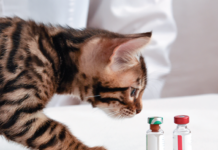Bigstock

One common reason for veterinary visits among cats is otitis externa, or inflammation of the external ear canal. Most people believe that that the term otitis externa means an ear infection, but that isnt true. Something has to breech the normal defense mechanism of the ear to trigger the infection, says veterinary dermatologist William H. Miller, Jr., VMD, Medical Director of the Cornell University Hospital for Animals.
Once the surface of the ear canal is damaged, bacteria or yeast inside and around the canal can cause an infection. The underlying causes can include tumors, allergies, ticks or fleas, and excessive grooming and ear wax. But by far the most frequent cause in cats, especially kittens, is ear mites.
Eight-legged Invaders. These tiny, eight-legged parasites in the ear canal feed by piercing the skin. Many kittens get ear mites, says Dr. Miller. Kittens huddle together with their mother and their littermates. If mom has it, they all will have it.
Stray cats are the most likely candidates for ear mite infestation. Allergies are a problem for other cats, with some developing an allergic otitis externa with a secondary yeast or bacterial infection.
The allergen can be a food, drug, parasite or environmental item such as pollen, dust mites or dander, Dr. Miller says. The ear canal lining contains mast cells which degranulate (release granules) when exposed to an allergen. This degranulation causes swelling, heat, moisture and itching, which predisposes the animal to infection. External itching makes things worse.
Signs an owner might notice depend upon the disease and the individual cat. They include head shaking, ear scratching, frequent yawning, malodorous ears, ear pain, head tilting and personality changes. If a crumbly, dark brown, waxy discharge resembling coffee grounds is seen within the ears, ear mites should be suspected.
An Interior View. Diagnosis starts with a physical examination to determine whether an ear disease is actually present. Veterinarians view the ear canal, ideally all the way down to the ear drum, with an instrument called an otoscope. This may require tranquilization or even anesthesia if the ear is very painful, Dr. Miller says.
Cytology (microscopic examination of the cells) within the ear discharge should then be performed. Depending on the case, the discharge will be examined for parasites or stained to look for bacterial or fungal infection. In cases where an ear tumor is suspected, tumor cells can sometimes be scraped from the ear canal for diagnosis. In cases of chronic or deep ear infections, an X-ray, CT scan or MRI may be warranted.
Treatment depends on the cause and the existence of a secondary infection. If the infection isnt too deep, a topical ear medication will be applied to the ear once to twice daily. If the infection alone is treated, but the underlying cause cant be found or isnt addressed, the infection is likely to recur, says Dr. Miller. If the cat has never had ear disease before, he should be examined by a veterinarian before any treatment is started. Something as simple as an ear cleaning done before the examination can change the cytologic findings, possibly leading to an inaccurate diagnosis. Cytology of the ear debris is an essential diagnostic tool.
Ear cleaning and ear drops are usually needed. Cleaning may be done once at the clinic or at home several times each week.
However, Dr. Miller cautions, For a good, safe home cleaning, a cat owner needs to know what he or she is doing. The technique can be learned at a veterinarians office. Also, the type of ear cleaning product and ear drops varies, depending upon which ear disease is being treated.
Most cases are easy to treat and resolve if caught early, Dr. Miller says. And the best way to catch otitis externa in its earliest stages is to pay attention to your pet. Notice whether your cat is flicking his ear, shaking his head more often than usual, doesnt welcome being petted around his head or has a strange odor around his head. All of these can be early signs of otitis externa. As the disease worsens, the signs will become more pronounced.
With prompt attention, however, most cats will return to normal in a week or two, Dr. Miller says.



